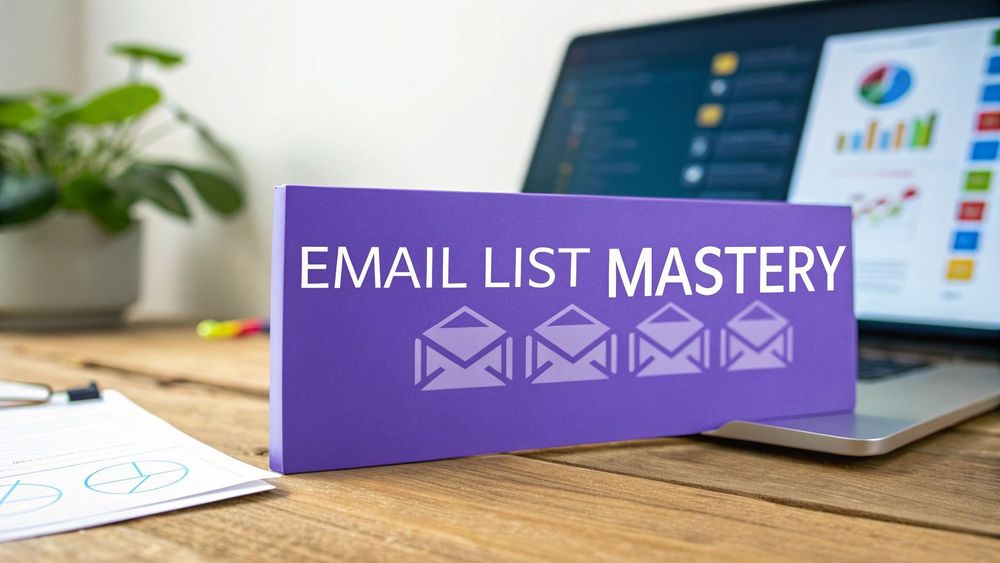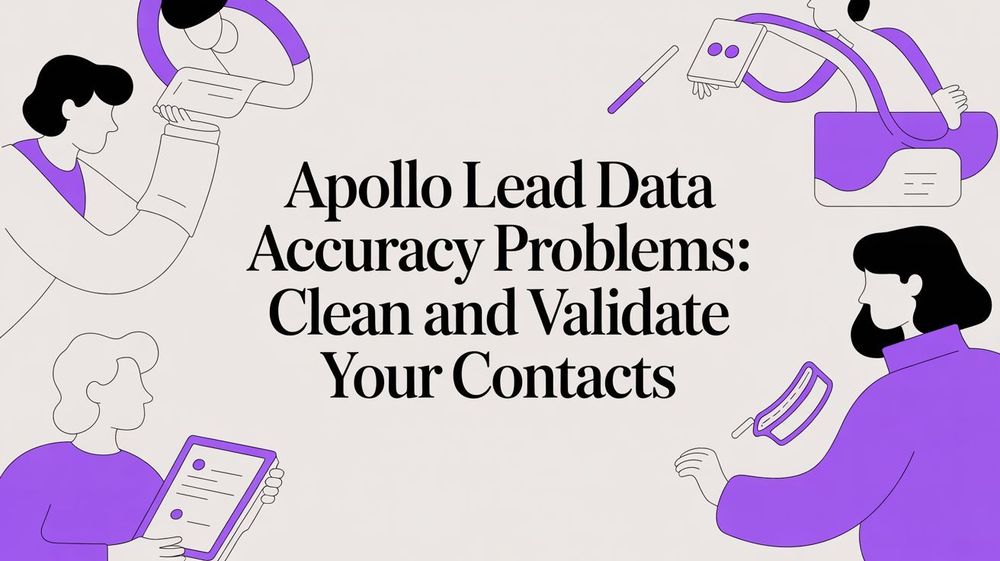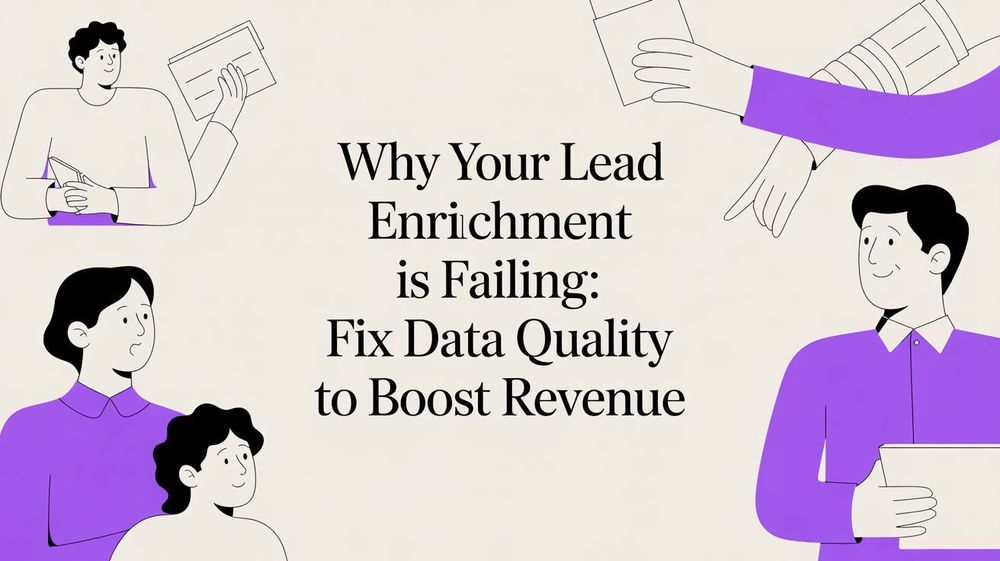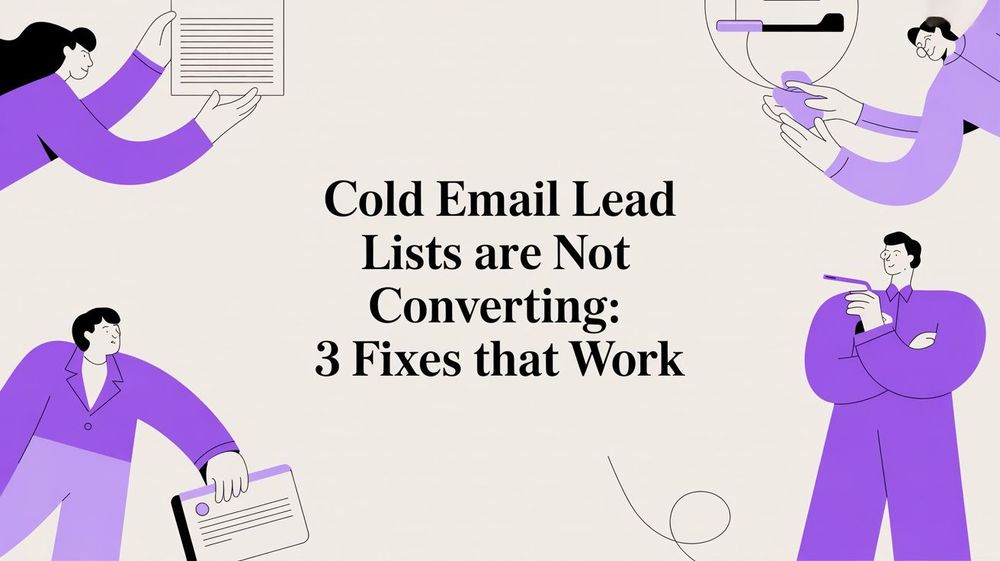Think of your email list as the one piece of digital real estate you truly own. Mastering email list building 101: from opt-ins to engagement is all about creating a direct, unfiltered line to your audience—one that isn't controlled by a fickle algorithm.
It’s a straightforward process: you attract people with something valuable (an opt-in), and then you build on that initial interest through smart, consistent communication (engagement). Done right, this turns casual website visitors into a loyal community that actually wants to hear from you.
Why an Owned Email List Is Your Most Valuable Asset
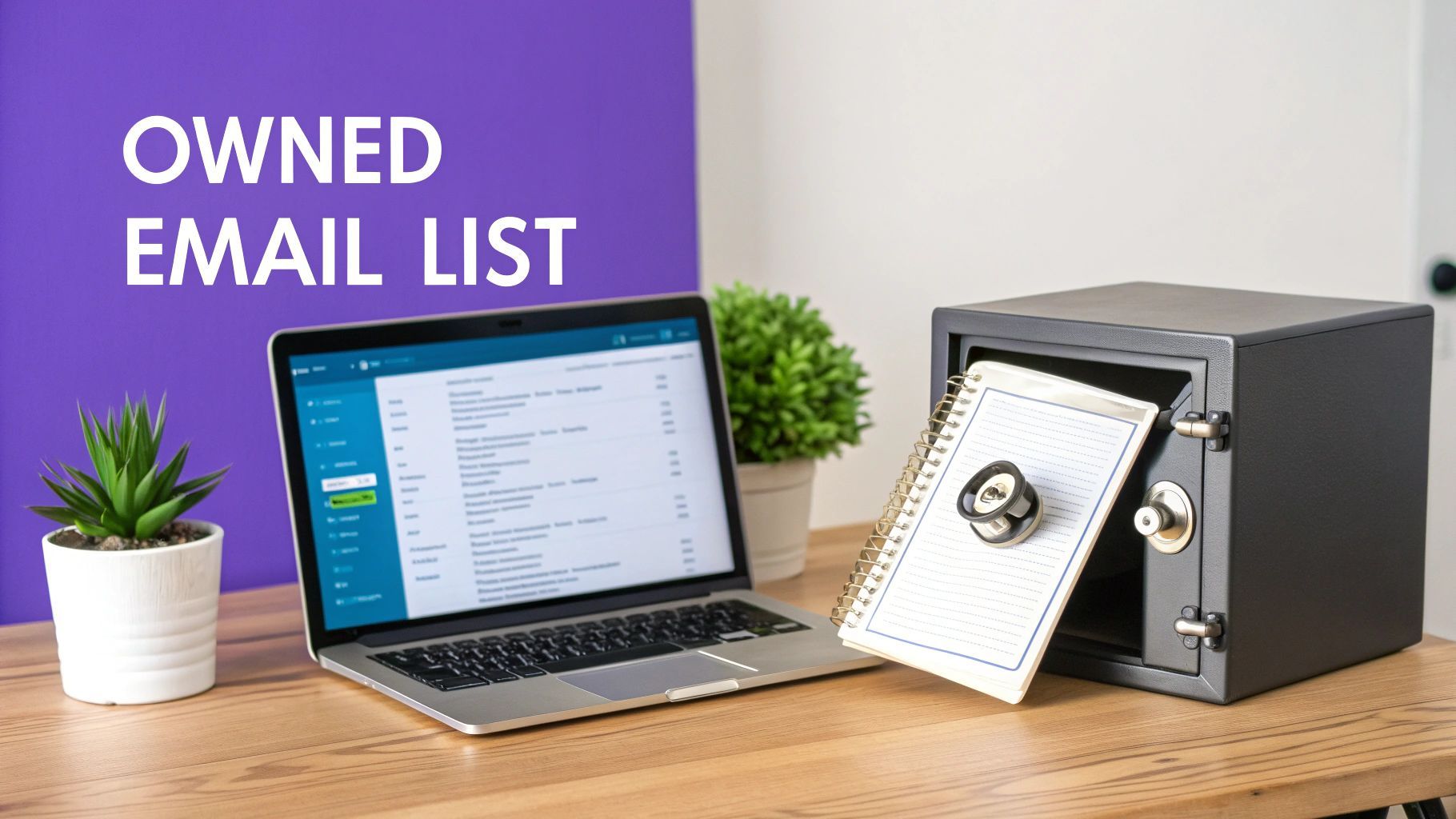
In a world where social media reach can vanish overnight and SEO rules are always in flux, your email list is your anchor. It’s the one channel where you call the shots. No platform update can take away the direct connection you have with people who have explicitly raised their hand and said, "Yes, I want to hear from you."
This guide breaks down the practical steps to build a high-quality email list. We'll cover everything from creating irresistible opt-ins to setting up automated sequences that turn new subscribers into engaged contacts.
The Power of Direct Communication
The biggest advantage here is control. You decide what to say, when to say it, and who sees it. There’s no algorithm burying your message.
This direct line is how you build real trust over time, which is pure gold for any sales pro, marketer, or recruiter. A well-tended list becomes a predictable engine for revenue and engagement. For a sales team, it's a way to drip-feed case studies to warm leads. For a recruiter, it’s a ready pool of talented candidates you can keep engaged with new opportunities. The secret is to always provide value, not just make asks.
Building a Resilient First-Party Data Asset
Let’s be honest: relying on third-party platforms is risky. Your audience and targeting options can disappear in an instant. That’s why building an email list you truly own—a first-party data asset—has become a strategic must-have.
The data you collect directly through your own opt-ins is more reliable, automatically more compliant with privacy laws, and delivers a much higher ROI.
Key Takeaway: An owned email list isn't just a list of contacts. It's a stable, high-return business asset that insulates you from the chaos of borrowed platforms like social media and search engines.
Modern tools have made the compliance and data capture side of things much easier, letting you focus on building a reliable marketing engine. For recruiters and sales teams, being able to quickly capture professional profiles and slot them into organized, private lists is a massive time-saver. It turns a tedious manual task into a smooth, efficient workflow.
If you want to go deeper on this, check out these 10 proven lead generation best practices that pair perfectly with a solid email strategy.
Crafting Lead Magnets People Actually Want
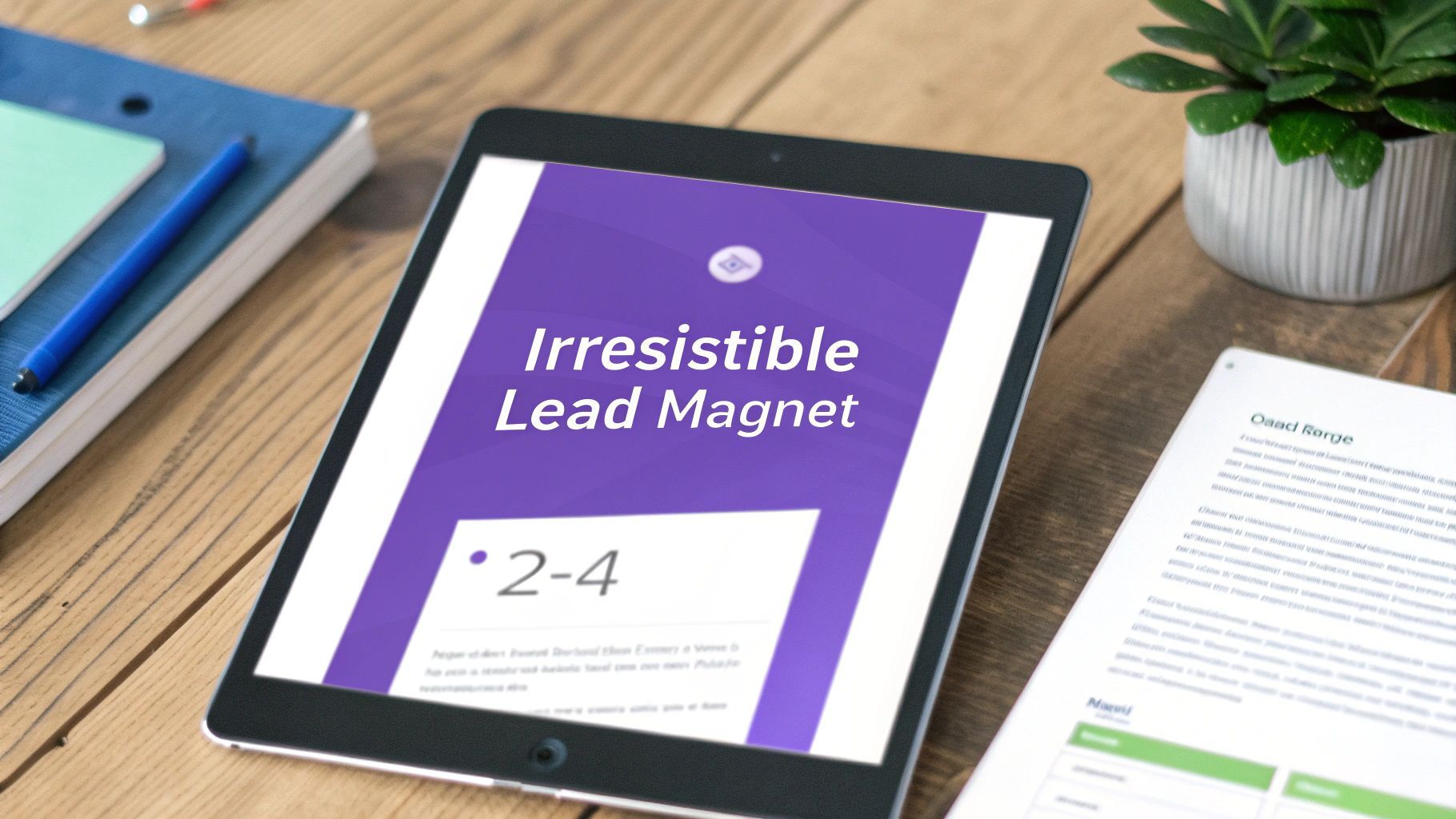
Think of an email address as a currency. To earn it, you have to make an offer so valuable that your audience feels like they're getting the better end of the deal. That’s the entire game with a great lead magnet—it’s not just another freebie, but a targeted solution to a real, urgent problem.
Forget the generic ebooks and checklists for a minute. The secret to building a quality email list is getting ultra-specific. A recruiter struggling to source candidates doesn't need another 50-page "Hiring Guide." What they really need is a set of five high-converting outreach templates they can copy, paste, and use today. That immediate, tangible value is what gets someone to hit "subscribe."
Aligning Your Offer with Audience Intent
Before you even think about design or copy, you have to get inside your audience's head. Why are they on your site right now? What problem are they trying to solve? Your lead magnet should be the very first, most logical step in that solution.
- For Recruiters: Ditch the ebook. Offer a checklist for "Screening Senior Software Engineers" or a template for a compelling LinkedIn InMail message.
- For Sales Teams: A generic sales guide is forgettable. A "Competitor Battlecard Template" or a "Discovery Call Script," on the other hand, is immediately useful.
- For Marketers: Go beyond a simple content calendar. Offer a "Canva Template Pack for Social Media Graphics" or a practical "Guide to Writing High-CTR Ad Copy."
The whole point is to provide a quick win. A solid lead magnet should deliver on its promise in under five minutes. This builds instant trust and positions your future emails as a source of practical solutions, not just more noise in their inbox. If you're looking for inspiration, exploring a comprehensive Leadmagnet Master Library can spark some incredible ideas.
High-Converting Lead Magnet Ideas by Persona
A powerful lead magnet speaks directly to a specific person's pain point. Generic offers get generic results, which is why we need to get granular. To help you nail this, here’s a breakdown of effective lead magnet types tailored to different professional roles.
| Target Persona | Pain Point | High-Value Lead Magnet Idea | Format |
|---|---|---|---|
| Recruiter | Writing outreach that gets replies from passive candidates | 5-Part Cold Outreach Email Template Sequence | PDF / Google Doc |
| Sales Professional | Running effective and structured discovery calls | The Ultimate Discovery Call Checklist & Question Bank | PDF / Notion Template |
| Marketer | Creating visually appealing social media content quickly | 10 Customizable Canva Templates for Instagram Stories | Canva Template Link |
| Researcher | Finding and organizing academic sources efficiently | A Curated List of Top 10 Niche Research Databases | Resource Guide (PDF) |
This approach ensures you're not just collecting emails, but attracting the right people who are genuinely interested in what you have to offer.
Designing for Conversion
Once you've locked in a high-value idea, its presentation is everything. A compelling, clean landing page is non-negotiable. It needs a clear, benefit-driven headline that echoes the user's problem right back at them. Use bullet points to hammer home the tangible outcomes they'll get after downloading.
Your copy should be tight and persuasive, focusing entirely on the value exchange. Building an email list is a fundamental pillar of modern marketing, and the numbers back it up. The pool of email users is projected to hit 4.6 billion globally by 2025, and welcome emails alone see an average open rate of 51%. That first interaction is critical. With 60% of consumers preferring to hear from brands via email, building your list with clear consent isn't just good practice—it's smart strategy.
A great lead magnet isn't about giving away your best work for free. It's about giving away a small, specific piece of your expertise that perfectly solves a single problem, proving you're the right person to solve their bigger ones.
Finally, think in layers. A visitor browsing your blog might be perfect for a simple checklist, but someone on a product page could be more receptive to a free demo or an in-depth case study. Tailoring your opt-ins to different stages of their journey shows you understand their needs and dramatically increases your chances of earning that all-important subscription.
Implementing Smart and Compliant Capture Methods
Once you’ve got an offer that people can’t refuse, it's time to set up the tech to actually capture those leads—efficiently and ethically. This is where your strategy gets real, turning casual website visitors into eager subscribers. The goal is to make saying "yes" to your offer completely seamless while respecting everyone's privacy.
The placement of your opt-in forms is a total game-changer. You don't want to be annoying, but you can't be so subtle that nobody even sees your offer. It's a fine line to walk, and it comes down to understanding how people actually behave on your site.
Strategic Placement of Opt-In Forms
Where you stick your forms can make or break your conversion rates. The trick is to present your lead magnet right when your visitor is most engaged or, funnily enough, just about to leave.
Here are a few high-impact spots I’ve seen work wonders:
- Header Bar: Think of it as a friendly, unobtrusive banner at the very top of your site. It keeps your offer visible without getting in the way.
- In-Content Forms: Placing a form smack in the middle of a relevant blog post catches readers when they're already nodding along with your expertise.
- Exit-Intent Pop-Ups: These only show up when a user’s mouse drifts toward the exit button. It’s your last chance to grab their attention with something truly compelling.
The real key is to test. What works for one audience might fall flat with another. A recruiter digging through your blog might jump on an in-content form offering a candidate outreach template. Meanwhile, a sales pro might be more tempted by an exit-intent pop-up for a competitor analysis worksheet.
Navigating Compliance with GDPR and CCPA
Email marketing compliance isn't just about ticking a legal box; it's about building trust. Regulations like GDPR in Europe and CCPA in California are all about giving people control over their personal data. For any marketer, salesperson, or recruiter, getting the basics right is non-negotiable.
Key Takeaway: Compliance isn't a hurdle. It's the foundation for a healthy, high-trust relationship with your subscribers. Being transparent about how you handle data shows you respect your audience.
One of the best habits to get into is the double opt-in. It's a simple two-step process: a new subscriber signs up, then they have to click a link in a confirmation email to actually be added to your list. Sure, it's an extra step, but it guarantees you're building a list of people who really want to hear from you. It also gives you rock-solid, documented consent, which is a lifesaver for compliance.
And don't forget your privacy policy. It needs to be clear, easy to find, and written in plain English—not legalese. Explain what data you collect, why you need it, and how people can ask you to delete it. Transparency is your best friend here.
A Modern Workflow for Building Targeted Lists
Let’s be honest, the traditional way of building a targeted list is a nightmare. For a recruiter, it means manually copying names, job titles, and company details from professional networking sites into a spreadsheet. This work is slow, tedious, and packed with human error, leaving you with a messy, unreliable dataset.
Thankfully, the modern, no-code alternative is here. A tool like ProfileSpider automates this whole process into a single click.
Imagine you're a recruiter sourcing candidates on LinkedIn or a sales pro prospecting on a company's "About Us" page. Instead of manual data entry, you can instantly extract all visible professional profiles with ProfileSpider's one-click AI. The engine grabs names, titles, companies, and locations, saving you hours of soul-crushing work.
Here’s a look at how ProfileSpider organizes that extracted data, making it clean and ready to go.
That clean interface shows the data is immediately structured and actionable. No manual cleanup needed.
This one-click workflow isn't just about speed; it's also about security and control. With ProfileSpider, all the data you extract is stored locally in your browser, never on an external server. This local-first privacy means you keep complete control over the information, helping you stay compliant.
Once your list is built, you can enrich it with missing details like work emails or phone numbers, then export it straight to your CRM or ATS. If you need more strategies on this front, our guide on how to find business email addresses offers even more practical tips. This modern approach turns list building from a painful chore into a fast, secure, and incredibly effective strategy.
How to Segment Your Contacts for Maximum Impact
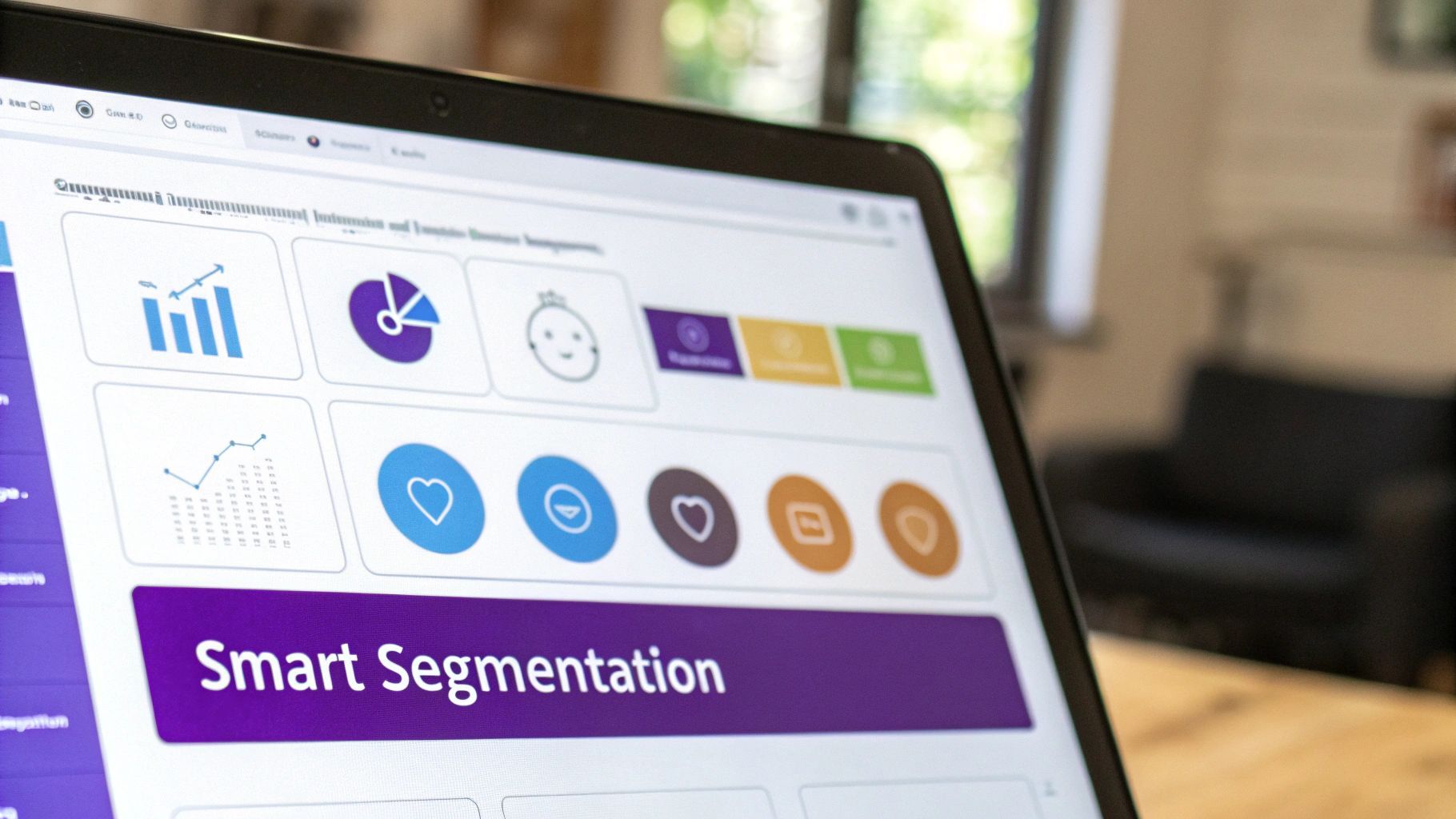
Sending the same generic message to everyone on your list is like shouting into a crowded room and just hoping the right person hears you. It’s a fast track to low engagement, high unsubscribes, and a whole lot of wasted effort.
The solution is list segmentation. This is the art of slicing up your audience into smaller, more focused groups to send highly relevant content. It speaks directly to a subscriber's specific needs, interests, or where they are in their journey with you. When an email feels personal, people are far more likely to open it, click on it, and actually take action.
The numbers don't lie. For list builders, segmented campaigns can generate around 30% more opens and 50% more click-throughs. It’s why over 78% of marketers rely on it to turn cold opt-ins into genuinely engaged leads.
Moving Beyond Basic Demographics
Look, effective segmentation goes way deeper than just grouping contacts by location or job title. The real magic happens when you start tracking subscriber behavior—paying close attention to the actions they take (or don't take).
Think about slicing up your list based on things like:
- Engagement Level: Who are your super-fans opening every email? And who hasn't clicked anything in months?
- Lead Magnet Origin: Did they grab your PDF, a template, or join a webinar? That tells you exactly what problem they’re trying to solve.
- On-Site Behavior: Did they linger on a specific product page or binge-read a certain category of blog posts?
- Purchase History: Grouping contacts into "first-time buyers," "repeat customers," or "hasn't purchased yet" is a goldmine for targeted offers.
This level of detail makes every message you send feel like it was written just for them, which completely changes the game. For anyone in the B2B space, mastering effective B2B market segmentation is how you maximize your outreach and close more deals.
Real-World Segmentation Scenarios
So what does this look like in the real world? Let's get practical.
A recruiter could break down their candidate pool by:
- Skill Set: Creating separate lists for "Java Developers," "UX Designers," and "Project Managers."
- Experience Level: Tagging candidates as "Junior," "Senior," or "Lead."
- Status: Keeping track of who is an "Active Candidate," "Passive," or "Not a Fit."
Meanwhile, a sales team might create segments for:
- Industry: Grouping leads from "SaaS," "Healthcare," or "Manufacturing."
- Company Size: Separating contacts from "Startups" versus "Enterprise" companies.
- Funnel Stage: Tagging prospects as "New Lead," "Qualified," or "Demo Scheduled."
Pro Tip: Start simple. You don't need dozens of complex rules on day one. A basic "Engaged vs. Inactive" segment can be incredibly powerful for running re-engagement campaigns.
Streamlining Segmentation with Smart Tools
The old-school way of doing this involves exporting messy spreadsheets from your email provider, sorting columns, and then re-uploading the filtered lists. It’s clunky, slow, and a recipe for mistakes.
This is where a modern tool like ProfileSpider overcomes these challenges. Instead of capturing a giant, disorganized mess of contacts, you can build segmented lists from the very beginning. As you extract profiles from sites like LinkedIn or company directories, you can organize them into unlimited custom lists right inside the tool.
Imagine a recruiter building a pipeline for a new role. They can create a list named "Senior Python Candidates Q3" and instantly add relevant profiles to it with one click. Sales teams can create lists by project, adding notes and tags to track leads without breaking a sweat.
And because all the data is captured and organized locally, it's completely private. When you're ready, ProfileSpider lets you export perfectly clean, segmented data into CSV, Excel, or JSON formats. That file is ready to upload straight into your CRM or email marketing platform, so every campaign you launch is targeted and relevant from the very first send.
Automating Engagement from Welcome to Conversion
Getting a new subscriber is a huge win, but let's be honest—it's just the starting line. The real magic happens in the follow-up. This is where you turn a curious visitor into a loyal fan, and a well-crafted, automated email sequence is your best tool for the job.
This automated process, which you’ll often hear called a drip campaign or a welcome series, makes sure every new person gets a consistent, high-value experience without you having to manually hit "send" each time. It’s your golden opportunity to make a killer first impression and guide them toward becoming a genuine part of your community.
Designing a High-Impact Welcome Sequence
The goal here is simple: deliver on the promise you made with your lead magnet and start building an actual relationship. You don't need a dozen complicated emails to pull this off. In my experience, a focused, four-part sequence is incredibly effective for warming up new leads.
Here's a breakdown of the blueprint I've seen work time and time again:
The Immediate Value Drop (Email 1): This needs to land in their inbox within minutes of them signing up. Its only job is to deliver the goods. No sales pitches, no long-winded stories—just pure, instant gratification. A subject line like "Here's the [Lead Magnet Name] you requested!" is perfect.
The Authority Builder (Email 2): Send this a day or two later. Now’s the time to show them why you're a credible voice in your space. Share a quick win, a powerful case study, or a personal story that connects directly to the problem they're trying to solve. This is all about building trust and proving you get it.
The Soft Call-to-Action (Email 3): You’ve delivered value and built some rapport, so now you can gently introduce a next step. This isn't a hard sell. It could be something as simple as inviting them to read a popular blog post, follow you on social media, or even just reply with their biggest challenge.
The Re-Engagement Check-in (Email 4): This one is for the people who haven't opened or clicked the last couple of emails. A simple, friendly check-in can bring them back into the fold. A subject line like "Did I lose you?" or "Just checking in" can be surprisingly effective at sparking a response.
If you're ready to explore more advanced automation, our guide on marketing automation workflow examples is packed with more templates and strategies you can put to work.
Essential Welcome Email Sequence Blueprint
To make this even more practical, here’s a template you can steal and adapt. This structure breaks down the timing, goals, and content for each email in your welcome series, helping you kick things off on the right foot.
| Email # | Timing | Primary Goal | Content Focus Example |
|---|---|---|---|
| 1 | Immediately After Opt-In | Deliver the Goods | "Here’s your [Checklist/Template]! Access it now and get started on [achieving X]." |
| 2 | Day 2 | Establish Authority & Trust | "I know [Pain Point] is tough. Here’s a quick story about how I solved it for a client." |
| 3 | Day 4 | Encourage Engagement | "If you found the checklist helpful, you'll love this deep-dive article on our blog." |
| 4 | Day 7 | Re-Engage & Offer Help | "Just checking in. Are you finding the resources helpful? Let me know if you have questions!" |
Think of this as your starting point. Test different timings and messages to see what resonates best with your audience.
Measuring What Matters for Optimization
You can't improve what you don't measure. An automated sequence isn't a "set it and forget it" machine—it's a living system you should be refining over time. Watching a few key metrics will tell you exactly what’s working and what needs a tune-up.
- Open Rate: Are your subject lines actually getting people's attention? If an email is falling flat here, it's time to A/B test a new, more compelling subject line.
- Click-Through Rate (CTR): This shows you if your content is interesting enough to make someone take the next step. If your CTR is low, take a hard look at your call-to-action (CTA). Is it crystal clear? Is the offer truly relevant?
- Conversion Rate: This is the big one. Are your subscribers ultimately taking the action you want them to, like booking a demo or buying a product?
- Unsubscribe Rate: A few people opting out is totally normal. But if you see a big spike after a specific email, that's a red flag. The content might be rubbing people the wrong way or just isn't what they expected.
Key Takeaway: Treat your automated engagement funnel like a living system. Use data, not guesswork, to optimize each step. Small tweaks to a subject line or a CTA can lead to significant improvements in engagement and conversion over time.
Where Do You Go From Here?
We've covered a lot of ground together, from designing your first opt-in to building out an entire automated system that nurtures new subscribers. If there's one thing to take away from all this, it's that a well-cared-for email list isn't just another marketing channel—it’s a reliable, owned asset that you can count on for real business growth.
It all boils down to a few core ideas that work time and time again:
- Create genuinely valuable lead magnets that solve a specific problem for your ideal customer.
- Use simple, compliant capture methods that build trust from the very first interaction.
- Get smart with segmentation so you can stop blasting everyone with the same message and start having relevant conversations.
- Automate your engagement to build relationships consistently, without you having to be there every second of the day.
Think about how a simple welcome sequence fits into this. It’s not just a random "hello"; it's a strategic conversation designed to guide someone from casual interest to active engagement.
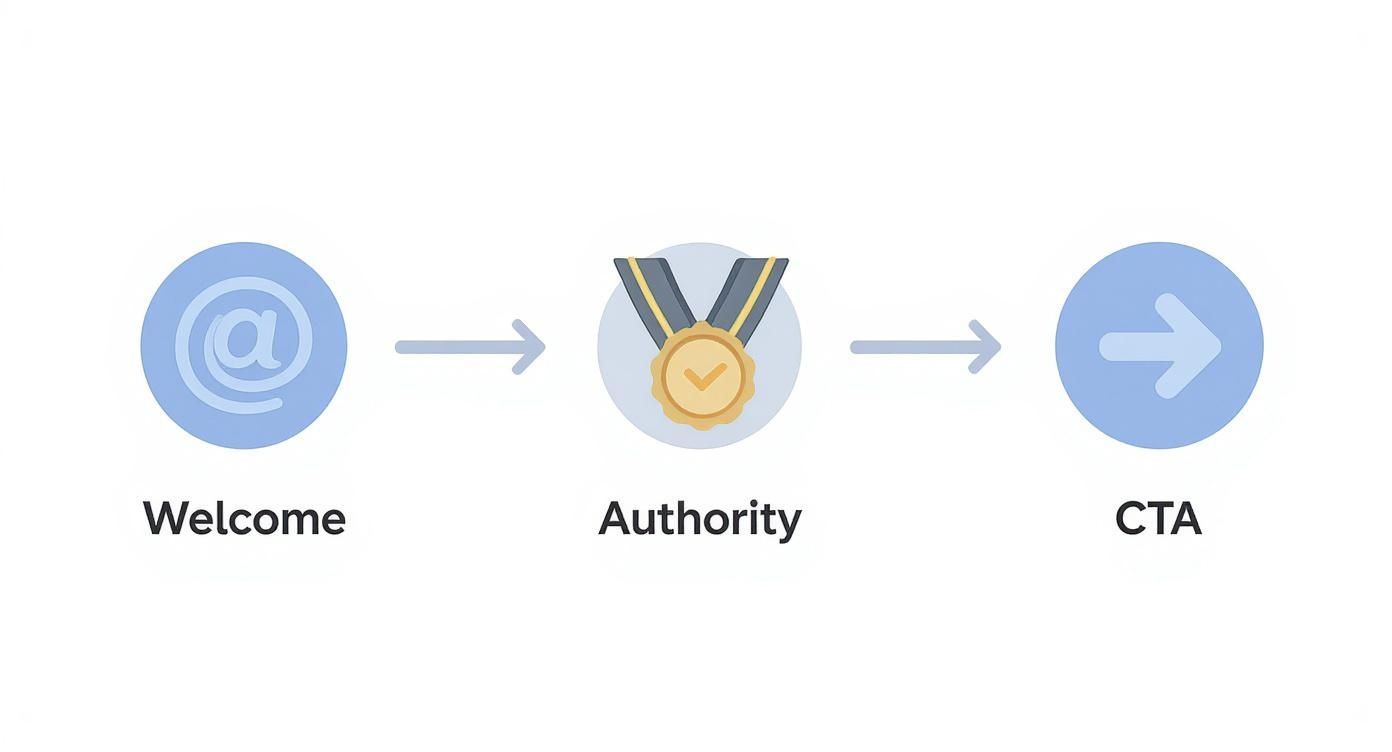
This flow shows exactly how it's done. You welcome them, establish your authority by providing value, and then give them a clear call to action. Each step builds on the last, creating a fantastic first impression that makes people want to stick around.
Your email list is the digital version of your professional network. Treat it with respect, give more than you take, and it will become the most dependable growth engine you have.
So, what's next? Don't try to do everything at once. Just pick one thing from this guide and get it done today. Maybe that's sketching out your first lead magnet or finally setting up that welcome sequence you've been putting off.
Whatever it is, that first step is always the most important one. Go build your most valuable asset.
A Few Lingering Questions
As you dive into the nitty-gritty of list building, a few practical questions always seem to pop up. Let's tackle some of the most common ones I hear, so you can move forward with confidence and build a list that actually works.
How Often Should I Be Emailing My List?
There’s no magic number here—it really comes down to your audience and what they expect from you. But if you’re looking for a solid starting point, once a week is a great rhythm for most.
The real key? Consistency and value. If every single email delivers a genuine insight or solves a real problem, your subscribers will look forward to hearing from you. Don't just email for the sake of it.
Keep an eye on your open and unsubscribe rates. If you decide to email more frequently and see a sudden jump in unsubscribes, that’s your audience telling you to pull back. It’s also a good idea to give people clear options to manage their email preferences so they feel in control.
What’s a Good Opt-In Conversion Rate?
Ah, the million-dollar question. A "good" conversion rate can be all over the map depending on your industry, where your traffic is coming from, and how compelling your offer is. That said, a general benchmark to shoot for is somewhere between 2% and 5%.
If you start hitting anything over 10%, you're doing exceptionally well.
My advice: Stop chasing some universal number and focus on beating your own last best score. A/B test everything—your headlines, your call-to-action buttons, your copy, the lead magnet itself. Small, steady improvements are what lead to massive list growth over time.
Is a Huge List Better Than a Super-Engaged One?
I'll take a smaller, highly engaged list over a massive, dormant one any day of the week. Engagement is the only metric that truly matters.
Think about it: high open rates, click-throughs, and conversions are direct signals that your audience is listening and trusts what you have to say. An engaged list doesn't just feel good; it leads directly to better sales and ensures your emails actually land in the inbox, because email providers see that people want your messages.
Your goal should always be to attract the right people and keep them hooked with quality content, not just to rack up subscriber numbers for bragging rights.

